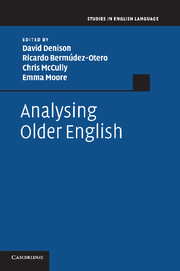Book contents
- Frontmatter
- Contents
- Figures and maps
- Tables
- Contributors
- General introduction
- Part I Metrics and onomastics in older English
- Part II Writing practices in older English
- Part III Dialects in older English
- Part IV Sound change in older English
- 12 Introduction to Part IV
- 13 Syllable weight and the weak-verb paradigms in Old English0
- 14 How to weaken one’s consonants, strengthen one’s vowels and remain English at the same time
- 15 Degemination in English, with special reference to the Middle English period
- Part V Syntax in older English
- References
- Index
13 - Syllable weight and the weak-verb paradigms in Old English0
Published online by Cambridge University Press: 05 December 2011
- Frontmatter
- Contents
- Figures and maps
- Tables
- Contributors
- General introduction
- Part I Metrics and onomastics in older English
- Part II Writing practices in older English
- Part III Dialects in older English
- Part IV Sound change in older English
- 12 Introduction to Part IV
- 13 Syllable weight and the weak-verb paradigms in Old English0
- 14 How to weaken one’s consonants, strengthen one’s vowels and remain English at the same time
- 15 Degemination in English, with special reference to the Middle English period
- Part V Syntax in older English
- References
- Index
Summary
Introduction
The conjoined noun phrases in my title should make it transparent that my interest is in the interplay of prosody and morphology and that my empirical base will be drawn from the paradigms of the Old English (OE) weak verbs. The initial focus of the study is the formation of the dental preterite and its relation to the surface taxonomy of the weak verbs, one of the venerable chestnuts of our repertoire.
In OE the original Germanic thematic vowel linking the stem and the inflections for one class of weak verbs was either syncopated or preserved; textbooks describe, for example, the first person singular preterite inflection as -(e)de, as in Figure 13.1a, while in Present-day English (PDE) the input form of the suffix is /-d/, with surface devoicing after voiceless consonants and schwa insertion (anaptyxis) in stems ending in [-t, -d], as in Figure 13.1b.
- Type
- Chapter
- Information
- Analysing Older English , pp. 194 - 212Publisher: Cambridge University PressPrint publication year: 2011

